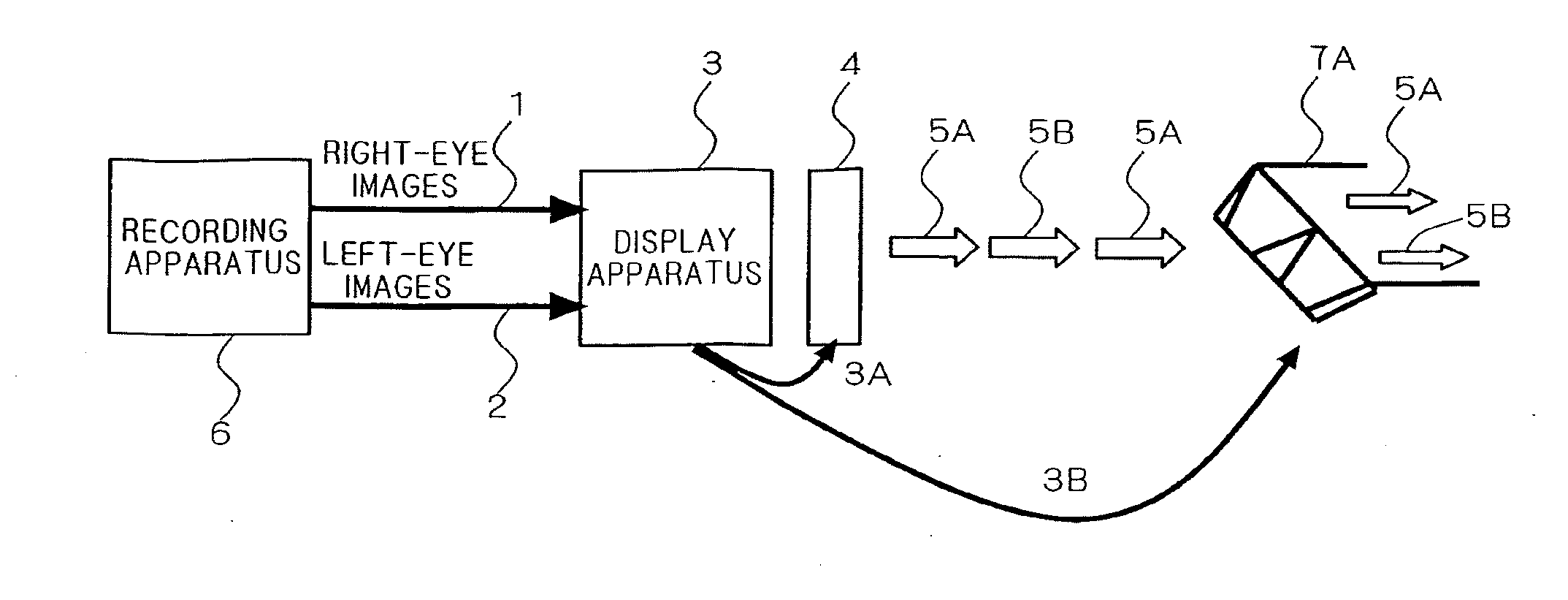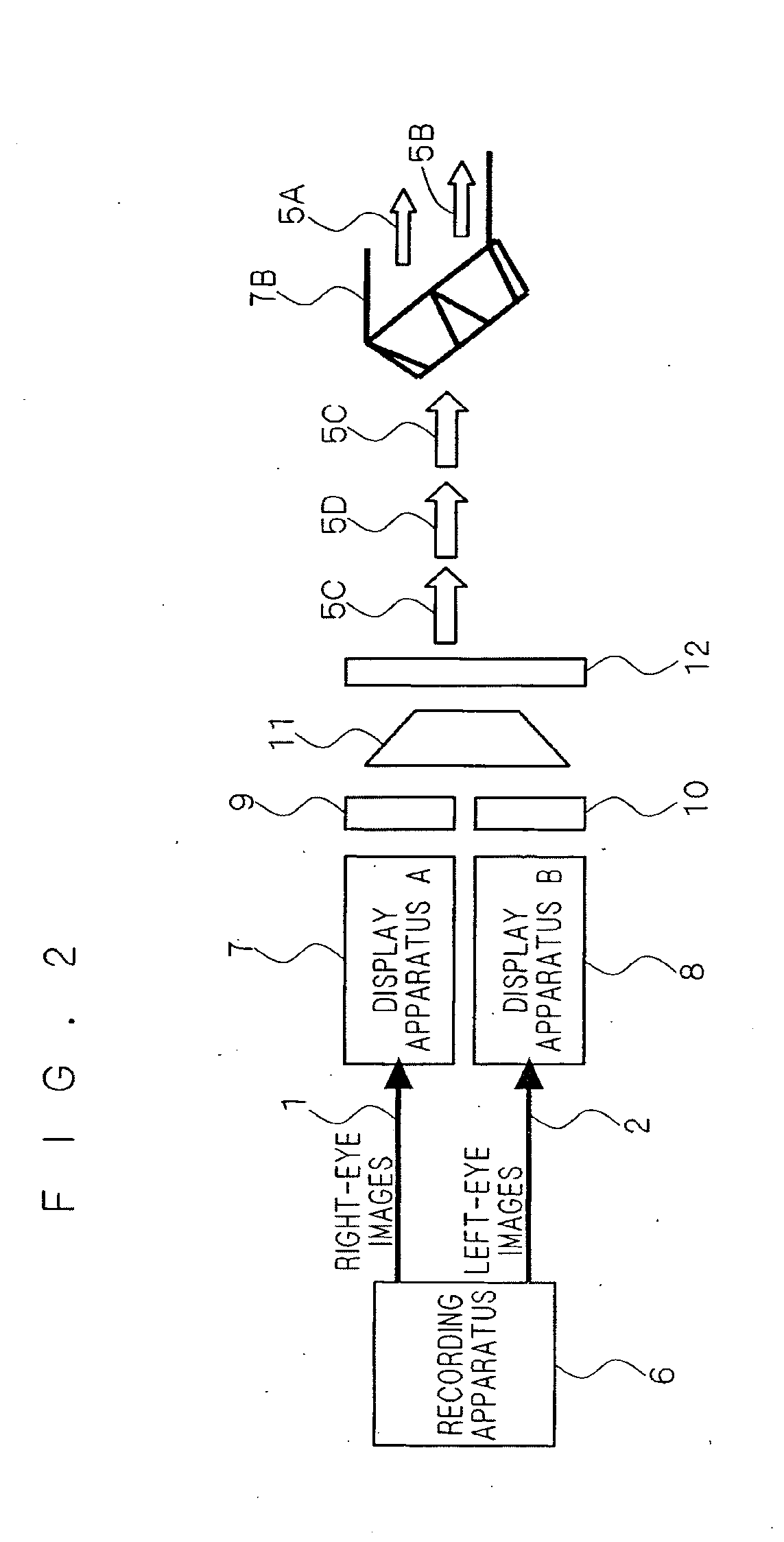Stereoscopic video recording method, stereoscopic video recording medium, stereoscopic video reproducing method, stereoscopic video recording apparatus, and stereoscopic video reproducing apparatus
a stereoscopic video and recording medium technology, applied in the field of stereoscopic video recording methods, can solve problems such as eye fatigue, 3d motion sickness, and difficult to perform stereoscopic video recording and reproduction, and achieve the effect of optimizing the recording and reproduction of stereoscopic video
- Summary
- Abstract
- Description
- Claims
- Application Information
AI Technical Summary
Benefits of technology
Problems solved by technology
Method used
Image
Examples
first preferred embodiment
[0064]A first preferred embodiment of the present invention will now be described referring to the drawings. FIG. 1 is a block diagram illustrating the overall configuration of a stereoscopic video system according to this preferred embodiment. The stereoscopic video system shown in FIG. 1 includes a stereoscopic video recording apparatus 6 (which will hereinafter be simply referred to also as a recording apparatus 6) for reproducing a medium that records stereoscopic video and outputting right-eye images 1 and left-eye images 2, a display apparatus 3 such as a TV or a projector, a shutter 4 composed of e.g. liquid crystal and capable of switching two transmissive polarized light rays, and eyeglasses 7A having liquid-crystal shutters on the left and right, or having different polarizing plates on the left and right, so as to view a frame sequence of video images 5A and 5B through the shutter 4. FIG. 2 illustrates another example of the configuration of a stereoscopic video system of...
second preferred embodiment
[0082]Next, a second preferred embodiment will be described referring to the drawings. When stereoscopic images utilizing parallax information, as shown in FIGS. 1 to 3, are intactly broadcasted on television, they are displayed like superimposed images. They cannot be viewed without a dedicated stereoscopic display apparatus constructed as described above. Thus, the broadcasting of stereoscopic video is limited by infrastructural facilities of equipment on the viewer side, and it is necessary to provide a dedicated channel that is not intended to be seen by people in general, or to superimpose a flag on the broadcasted information to indicate that it is 3D. Accordingly, it is generally convenient to distribute such stereoscopic video in the form of a recording medium, and to reproduce it with a dedicated player or with a player having this function. Considering such circumstances, methods and formats for storing stereoscopic video in a recording medium will now be described.
[0083]F...
third preferred embodiment
[0126]Next, a third preferred embodiment will be described. FIG. 24 is a block diagram of a stereoscopic video recording apparatus according to the third preferred embodiment. The stereoscopic video recording apparatus shown in FIG. 24 includes AD converters 146 for digitizing video signals respectively for the right-eye and left-eye images of stereoscopic video utilizing parallax information, motion vector detectors (motion detectors) 147 necessary for video compression in the temporal direction, DCT transform circuits 148 necessary for intra-compression, adaptive quantization circuits 149 necessary for intra-compression, and inverse quantization circuits 150 for local decoders. The stereoscopic video recording apparatus of FIG. 24 also includes variable-length coding circuits 151 necessary for intra-compression, inverse DCT transform circuits 152 for local decoders, frame memories 153 for local decoders, a buffer memory 154 for storing data after compressed, an OSD information enc...
PUM
| Property | Measurement | Unit |
|---|---|---|
| viewing angles | aaaaa | aaaaa |
| optical | aaaaa | aaaaa |
| depth | aaaaa | aaaaa |
Abstract
Description
Claims
Application Information
 Login to View More
Login to View More - R&D
- Intellectual Property
- Life Sciences
- Materials
- Tech Scout
- Unparalleled Data Quality
- Higher Quality Content
- 60% Fewer Hallucinations
Browse by: Latest US Patents, China's latest patents, Technical Efficacy Thesaurus, Application Domain, Technology Topic, Popular Technical Reports.
© 2025 PatSnap. All rights reserved.Legal|Privacy policy|Modern Slavery Act Transparency Statement|Sitemap|About US| Contact US: help@patsnap.com



